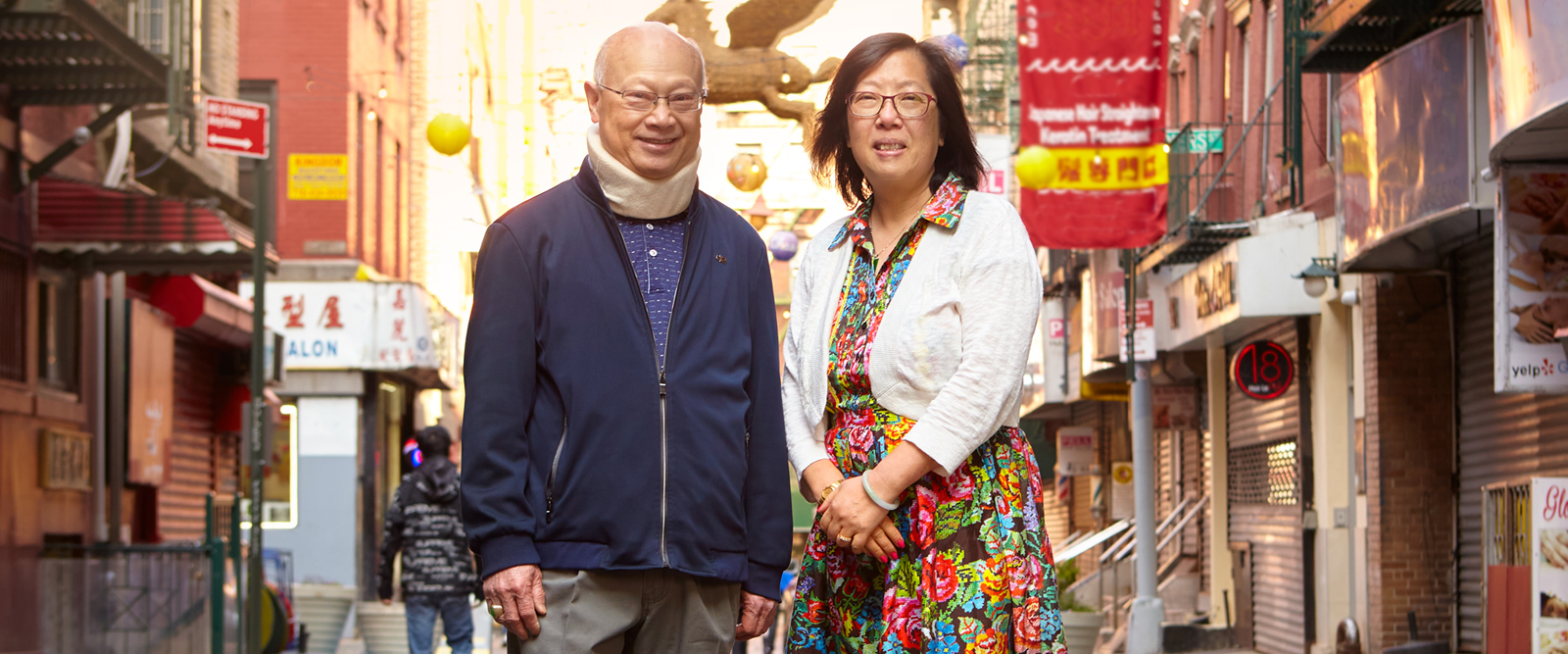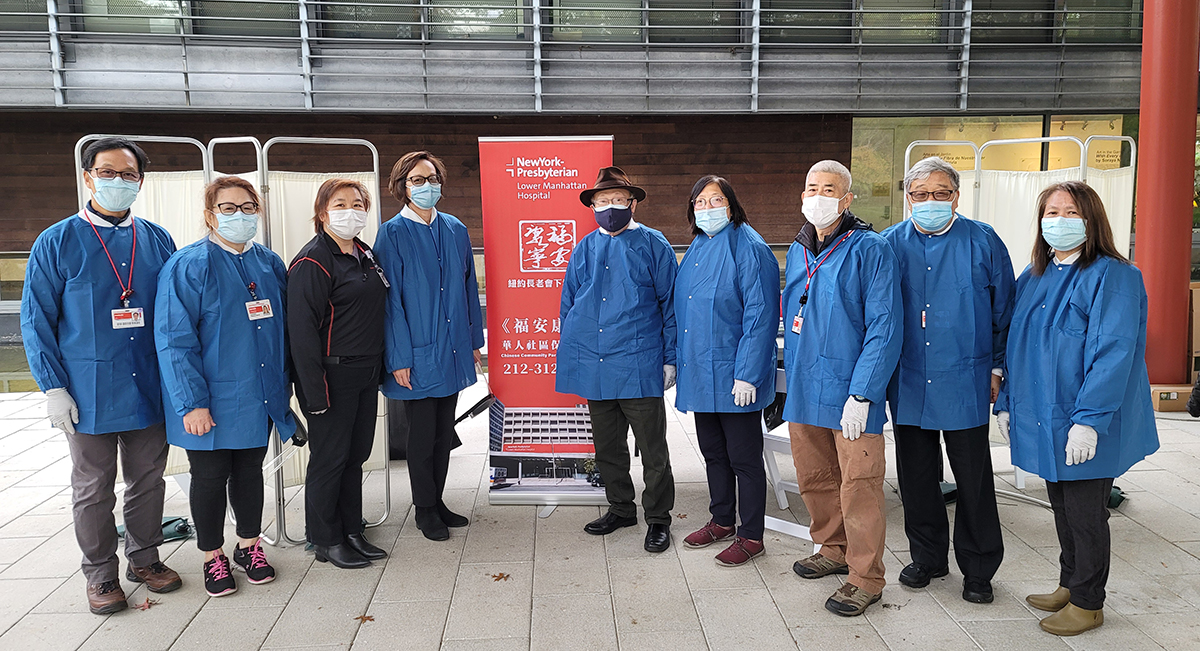Caring for Their Own Community
The Chinese Community Partnership for Health brings health care workers into Chinese communities in Manhattan, Queens, and Brooklyn, helping residents overcome language and cultural barriers to address unmet health care needs.

Dr. Eric Poon (left) and Chui Man Lai.

Dr. Eric Poon (left) and Chui Man Lai.
As he strolls through Manhattan’s Chinatown, Dr. Eric Poon finds himself in a neighborhood that has many familiar sights and sounds, and yet has transformed in many ways since he first moved to New York City in the 1970s. Back then, the area was dotted with garment factories, where thousands of workers — his mother included — made a living. He recalls when there were only a handful of doctors in Chinatown, and thinks back to the diversifying waves of immigrant populations from China arriving in the ’80s and ’90s as the communities grew and moved to Sunset Park in Brooklyn and Flushing in Queens.
While the industries, businesses, and residents have changed, one thing has remained constant for Dr. Poon: his commitment to helping his neighbors.
In 1993, Dr. Poon, along with a group of community leaders including Lai Wah Fung, co-founded what is now known as the NewYork-Presbyterian Lower Manhattan Hospital Chinese Community Partnership for Health (CCPH), an outreach program aimed at educating and supporting people in New York City’s Chinatown so they can lead healthier lifestyles.
What started out as a health screening inside a Chinatown garment factory has expanded to helping improve health care access for more than 200,000 people across the boroughs over the past 30 years. As one of four medical providers on the CCPH board, Dr. Poon has conducted in-person and online health lectures along with initiatives like diabetes prevention workshops, and flu vaccinations with help from two nurses, a CCPH program manager, and an event coordinator.
“For some people who may not want to see a doctor, are afraid to go to the hospital, or they’re underserved and believe that they can’t access care, we want to show them we’re here for them,” says Dr. Poon, a pediatrician at NewYork-Presbyterian and CCPH committee member.
A Mission to Serve
When Dr. Poon arrived in the United States from Hong Kong in 1970, the then-20-year-old worked his way through college as a dishwasher, waiter, chef’s assistant, and maître d’ before pursuing medicine and joining what is now NewYork-Presbyterian Lower Manhattan Hospital in 1986 and starting his Chinatown practice.
“Back then it was a very close-knit community, with people coming from all over China and starting their lives here, and we all helped each other,” says Dr. Poon, who is also a clinical assistant professor of pediatrics at Weill Cornell Medicine.
Even as Chinatown continued to grow, access to healthcare remained a challenge for members of the community.
“Many people only think of the hospital as the emergency room, or they’ll come up with reasons why they don’t need to see a doctor,” he says. “They don’t have the time to go because they’re working, or they feel they’re cured of a condition after a routine visit. A group of us physicians realized there was a need for better health education.”
With the help of grants and support from local organizations, labor unions, community service organizations, public schools, and businesses, Dr. Poon and his colleagues kicked off health talks and pop-up screenings throughout Chinatown.
“We started in the factories to meet people where they were, whether it was on their lunch break or at their job, and eventually hosted screenings that had 300 to 400 people in attendance,” Dr. Poon says.
Physicians, nurses, and outreach workers appeared on local Chinese radio talk shows to provide new Chinese immigrants with information from primary care providers, with emphasis on preventive medicine and the importance of routine checkups.

The NewYork-Presbyterian Lower Manhattan Hospital Chinese Community Partnership for Health (CCPH) team.
Expanding Access
The program grew over the decades with a focus on health literacy, along with detecting and preventing chronic disease, explains Chui Man Lai, community affairs manager at NewYork-Presbyterian Lower Manhattan Hospital.
“We’re aware of the cultural sensitivities, and it’s important for us to instill the values of multigenerational care within families,” Lai says. “We want to reach not only the elderly, but people who are taking care of young children and those who may be caregivers for their parents, so everyone has a better quality of life.”
As a pediatrician, Dr. Poon helped lead the charge in hosting vision and hearing screenings at local elementary schools, which continue to this day.
“Dr. Poon never gave up in helping fill the needs that he saw,” Lai says. “He was always willing to go the extra mile for the neighborhood.”
The landscape of Lower Manhattan was altered after the September 11 attacks, and many Chinese workers and families left Manhattan’s Chinatown as the economic climate led to shutdowns of garment factories, restaurants, and neighborhood businesses, Dr. Poon says.
As a result, CCPH extended offerings to other major Chinese communities in Sunset Park and Flushing, while continuing to serve the Lower Manhattan community, expanding their educational talks, vaccinations and screenings for blood pressure, glucose, and cholesterol. The team also developed a Lung Disease Prevention Program to combat tobacco use, including classes for food industry workers.
“In our communities, we still have a lot of underserved populations, some of whom don’t have legal status,” Lai says. “For those who have insurance, they may not know how to utilize it. We provide support, guidance, and people really depend on us to navigate the health system.”
As the neighborhoods and populations changed, the CCPH team saw attendance grow, they say, along with a willingness in attendees to make health part of their everyday lives.
“Their Preventive Type 2 Diabetes program helped me be more mindful of my daily diet and the importance of exercise to maintain a healthy lifestyle,” says Yat Lung Li, a participant in one of the many CCPH initiatives.
A Community Lifeline
The COVID-19 pandemic magnified the necessity of connection and access to healthcare, particularly among the elderly population.
In 2021, Lai and her team made more than 900 check-in calls to residents in Chinatown, many of whom don’t speak English. With in-person meetings no longer an option, they taught seniors how to transition to virtual platforms, using Zoom to give health talks.
“We helped them find places to refill their medication and prepared people in case they needed to come to the emergency room during the height of the pandemic,” Lai says. “We provided encouragement and tried to lessen their fears, especially when it came to language, reminding them of our interpreter services. People came to see us as a lifeline during this difficult time.”
Topics for the dozens of health lectures included COVID-19 vaccines, Asian hate crimes, stress and anxiety, and smoking cessation, and more than 3,500 people tuned in virtually. The CCPH team conducted screenings for hepatitis B and C and expanded a new initiative to raise awareness of colorectal cancer.
Research plays a big role in the program, such as a recent diabetes prevention program examining the impact of culturally sensitive lifestyle intervention methods in Chinese American and immigrant communities to help reduce health disparities.
As Dr. Poon reflects on his nearly four decades in New York City’s Chinatown, he and the team look forward to returning to more and more in-person events and reuniting with familiar faces who have attended over the years.
“Even after 30 years, this program is still needed to serve the people and provide guidance to help them take control of their health,” he says. “Our purpose is to continue to bring the hospital to the community.”
Additional Resources
Learn how NewYork-Presbyterian is working closely with our communities to improve health.

